Saturday, September 30, 2017
"This poem is concerned with language on a very plain level."
— "Paradoxes and Oxymorons" by John Ashbery,
quoted here in the post Take Your Pick of Dec. 16, 2011.
"The problem is a paradox of the veridical type,
because the correct result (you should switch doors)
is so counterintuitive it can seem absurd,
but is nevertheless demonstrably true."
— Wikipedia on the Monty Hall problem.
Related material —

Comments Off on Paradoxes for Oxymorons
From the online New York Times this morning —
"Origin is Mr. Brown’s eighth novel. It finds his familiar protagonist,
the brilliant Harvard professor of symbology and religious iconography
Robert Langdon, embroiled once more in an intellectually challenging,
life-threatening adventure involving murderous zealots, shadowy fringe
organizations, paradigm-shifting secrets with implications for the future
of humanity, symbols within puzzles and puzzles within symbols and
a female companion who is super-smart and super-hot.
As do all of Mr. Brown’s works, the new novel does not shy away from
the big questions, but rather rushes headlong into them."
— Profile of Dan Brown by Sarah Lyall
See also yesterday's Log24 post on the Feast of St. Michael and All Angels.
Comments Off on Where Angels Fear to Tread
Friday, September 29, 2017
(Some Remarks for Science Addicts)
Principles —

Personalities —

* See "Tradition Twelve."
Comments Off on Principles Before Personalities*
Thursday, September 28, 2017
From the New York Times Wire last night —
"Mr. Hefner … styled himself as an emblem
of the sexual revolution."
From a Log24 post on September 23 —

A different emblem related to other remarks in the above Sept. 23 post —

(On the wall — a Galois-geometry inscape .)
Comments Off on Core
Remarks suggested by the previous post —
|
From Jeremy Biles, "Introduction: The Sacred Monster," in
Ecce Monstrum: Georges Bataille and the Sacrifice of Form
(Fordham University Press, 2007, page 3) —
Bataille’s insistent conjunction of the monstrous and the sacred is the subject of this book. Regarded by many as one of the most important thinkers of our time, and acknowledged as an important influence by such intellectuals as Michel Foucault, Julia Kristeva, Maurice Blanchot, and Jacques Derrida, Bataille produced a corpus of wide-ranging writings bearing the monstrous marks of the affective and intellectual contradictions he also sought to produce in his readers. In the following chapters, I will specify some of the ways in which Bataille evokes monstrosity to elicit in himself and his audience an experience of simultaneous anguish and joy—an experience that he calls sacred. In particular, Bataille is fascinated with the ‘‘left-hand’’ sacred. In contradistinction to its lucent and form-conferring ‘‘right-hand’’ counterpart, the left-hand sacred is obscure and formless—not transcendent, pure, and beneficent, but dangerous, filthy, and morbid. This sinister, deadly aspect of the sacred is at once embodied in, and communicated by, the monster. As we will see, it is in beholding the monster that one might experience the combination of ecstasy and horror that characterizes Bataille ’s notion of the sacred.
The dual etymology of ‘‘monster’’ reveals that aspect of the sacred that enticed Bataille. According to one vein of etymological study, the Latin monstrum derives from monstrare (to show or display). The monster is that which appears before our eyes as a sign of sorts; it is a demonstration. But another tradition emphasizes a more ominous point. Deriving from monere (to warn), the monster is a divine omen, a portent; it heralds something that yet remains unexpected, unforeseeable—as a sudden reversal of fortune. In the writings of Bataille, the monster functions as a monstrance, putting on display the sinister aspect of the sacred that Bataille sees as the key to a ‘‘sovereign’’ existence. But in doing so the monster presents us with a portent of something that we cannot precisely foresee, but something that, Bataille claims, can be paradoxically experienced in moments of simultaneous anguish and ecstasy: death.
|
See as well …

(Order of news items transposed for aesthetic effect.)
Comments Off on The Last Word
Wednesday, September 27, 2017
Tuesday, September 26, 2017
The title is that of an exhibition at Boston's Museum of Fine Arts
that opened on Sunday, September 24.
See the previous post and some Chinese background
from The Cornell Daily Sun today —
"John W. Lewis, the University’s first professor of Chinese government
and one of the first major China specialists who came out against the
Vietnam War, died on Sept. 4 in Stanford, California. He was 86."

Still enough for you?
Comments Off on Seeking Stillness
" . . . Only by the form, the pattern,
Can words or music reach
The stillness, as a Chinese jar still
Moves perpetually in its stillness."
— Four Quartets
See posts now tagged Myspace China.
Comments Off on Happy Birthday, T. S. Eliot
Monday, September 25, 2017

Related story —
MSU to award honorary doctorate to
Harvard professor Diana Eck
March 8, 2013 — MSU News Service
See also Bozeman and "Ein Eck" in this journal.
Comments Off on Bozeman Eck
Sunday, September 24, 2017
"On April 23, 2009 ….
'I’m reminded of the character in "The Silence of the Lambs,"
Hannibal Lecter, a very brilliant man,' the prosecutor said,
recognizing 'his ability to intelligently and articulately discuss
things occurring in society.'
'But at his core, as with Mr. Lecter at his core, he is a sociopath,'
the prosecutor said."
— David Stout in an obituary from this evening's online
New York Times
See also this journal on April 23, 2009, and
a figure from this morning's link Cantina —
 .
.
Comments Off on Figures
Comments Off on Sunday School
Saturday, September 23, 2017
Comments Off on The Turn of the Year
"With respect to the story's content, the frame thus acts
both as an inclusion of the exterior and as an exclusion
of the interior: it is a perturbation of the outside at the
very core of the story's inside, and as such, it is a blurring
of the very difference between inside and outside."
— Shoshana Felman on a Henry James story, p. 123 in
"Turning the Screw of Interpretation,"
Yale French Studies No. 55/56 (1977), pp. 94-207.
Published by Yale University Press.


See also the previous post and The Galois Tesseract.
Comments Off on The Turn of the Frame
Friday, September 22, 2017
"The story’s origin is therefore situated, it would seem, in
a forgetting of its origin: to tell the story’s origin is to tell
the story of that origin’s obliteration."
— Shoshana Felman, p. 122 in
"Turning the Screw of Interpretation,"
Yale French Studies No. 55/56 (1977), pp. 94-207.
Published by Yale University Press.

The Preface

Comments Off on February 11 Note
Thursday, September 21, 2017


For Valéry's phrase "an extreme depth, a torment of thought," see
(via a link from the reported date of the above publisher's death, Aug. 31)
a post of July 15, 2004.
Comments Off on LIFE and Abstract Thought
Comments Off on Product Placement
Wednesday, September 20, 2017
In memory of Lillian Ross, who reportedly died early today —
An Abstract Power.
* As opposed to The Imaginary Professor.
Comments Off on The Real Reporter*
- I was a teacher.
- You're being modest, aren't you?
You were a professor at Boston University...
Isn't that right?
- Yes, well, assistant professor.
- And what'd you teach?
- Philosophy. Truth and logic.
That sort of thing.
Read more:
https://www.springfieldspringfield.co.uk/
movie_script.php?movie=gifted
Compare and contrast with a real Boston University professor,
John Stachel, quoted here on Sept. 5, 2017.
Comments Off on The Imaginary Professor
… from the previous post. See also Spectre in this journal.


Comments Off on Time and Chance Continues …
Tuesday, September 19, 2017
Comments Off on Time and Chance
Monday, September 18, 2017
Lt. Col. Stanislav Petrov, "the man who saved the world," reportedly died
at 77 in a town near Moscow on May 19, 2017.
A figure from last night's post appeared in this journal on that date.
Comments Off on In Memoriam
Sunday, September 17, 2017
… who reportedly died at 62 late on Thursday, Dec. 15, 2011.

Related material — The "What As Is" link above, and a Sept. 14 post
quoting art critic Roberta Smith on a current exhibition —
"You grab your experiential richness where you find it."
— Roberta Smith, "Postwar Art Gets a Nervy Makeover"
in the online New York Times
Comments Off on For St. Christopher (Hitchens)

For the other two brothers, see Feininger in this journal.
Comments Off on The Third Brother
"My guess is you're looking for
the least, little entity."
— Subtitle in "The Zero Theorem"
from the previous post.
Related material —

See as well some purely mathematical properties of a byte
discussed here on July 7, 2011.
Comments Off on Scholium
Saturday, September 16, 2017
The above passage was suggested by an IMDb release date —

— and by a Log24 post, Lux, of the same date: 19 August, 2014.
See also photos by a big brother of Lux Feininger in this journal
on Wednesday, August 30, 2017.
Comments Off on Fiat
From "The Metaphysics of Entities," a post of Sept. 20, 2014 —
Anthony Lane in The New Yorker on a 2013 film —
"The hero of 'The Zero Theorem' is a computer genius
called Qohen Leth (Christoph Waltz)…. He is the sole
resident of a derelict church, where, on a crucifix in front
of the altar, the head of Christ has been replaced by a
security camera. No prayers are ever said, and none are
answered."
Related dialogue from a 2008 film —

Another view of the Zero Theorem derelict church —

Comments Off on The Zero Monstrance
Friday, September 15, 2017
Silas in "Equals" (2015) —
Ever since we were kids it's been drilled into us that …
Our purpose is to explore the universe, you know.
Outer space is where we'll find …
… the answers to why we're here and …
… and where we come from.
Related material —
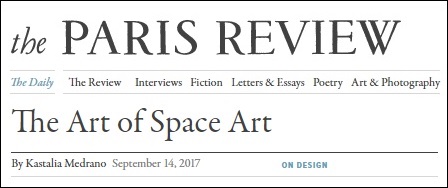
See also Galois Space in this journal.
Comments Off on Space Art
Thursday, September 14, 2017
( A sequel to the previous post, Lost )
From a link, "A Little Boy and a Little Girl," found in a Log24
search for Andersen + Atlantic —

"A few flakes of snow were falling, and one of them, rather larger
than the rest, alighted on the edge of one of the flower boxes.
This snow-flake grew larger and larger, till at last it became
the figure of a woman, dressed in garments of white gauze,
which looked like millions of starry snow-flakes linked together.
She was fair and beautiful, but made of ice—
shining and glittering ice." — "The Snow Queen"
Related material —

Analogue of the little boy from "The Snow Queen" in "Equals" (2015) —

"Nice piece of ice." — Brendan Fraser in
"The Mummy: Tomb of the Dragon Emperor" (2008).
See also the concept that everything adds up to nothing in
"The Zero Theorem" (2013) …

… and the Conway-Norton-Ryba theorem (2017).
Comments Off on Found …


"You grab your experiential richness where you find it."
— Roberta Smith, "Postwar Art Gets a Nervy Makeover"
in the online New York Times today
Comments Off on Lost

From this journal on the above publication date —

Related material — Geometric Group Theory in this journal.
Comments Off on Group Actions
Wednesday, September 13, 2017
The previous two posts dealt, rather indirectly, with
the notion of "cube bricks" (Cullinane, 1984) —
Group actions on partitions —

Cube Bricks 1984 —

Another mathematical remark from 1984 —

For further details, see Triangles Are Square.
Comments Off on Summer of 1984
Tuesday, September 12, 2017
The New York Times online this evening —
"Mr. Jobs, who died in 2011, loomed over Tuesday’s
nostalgic presentation. The Apple C.E.O., Tim Cook,
paid tribute, his voice cracking with emotion, Mr. Jobs’s
steeple-fingered image looming as big onstage as
Big Brother’s face in the classic Macintosh '1984' commercial."
— James Poniewozik
Review —
|
Thursday, September 1, 2011
Filed under: Uncategorized — Tags: Geometry, Priority — m759 @ 11:00 AM
"Design is how it works." — Steven Jobs (See Symmetry and Design.)
"By far the most important structure in design theory is the Steiner system S(5, 8, 24)."
— "Block Designs," by Andries E. Brouwer
. . . .
|
See also 1984 Bricks in this journal.
Comments Off on Think Different


Related image suggested by "A Line for Frank" (Sept. 30, 2013) —

Comments Off on Chin Music
"Truth and clarity remained his paramount goals…"
— Benedict Nightingale in today's online New York TImes on an
English theatre director, founder of the Royal Shakespeare Company,
who reportedly died yesterday at 86.
See also Paramount in this journal.
Comments Off on Goals
Monday, September 11, 2017
A sentence from the New York Times Wire discussed in the previous post —

"Through characters like Wolverine and Swamp Thing,
he helped bring a new depth to his art form."
For Wolverine and Swamp Thing in posts related to a different
art form — geometry — see …
Comments Off on New Depth
A flashback from the previous post, "Leave a Space" —

From my RSS feed this evening —
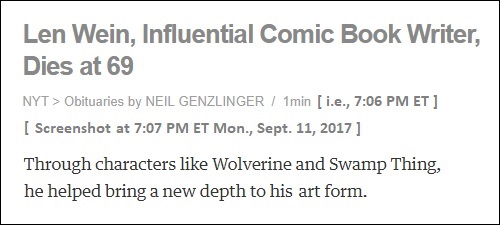
Related material from the Web —

Len Wein reportedly died on Sunday.
An image from this journal on Sunday —

" There was an Outer Limits episode called 'The Architects of Fear.'
I thought: 'Wow. That’s a bit close to our story.' " — Alan Moore
— https://www.bleedingcool.com/2013/01/29/
len-wein-the-outer-limits-and-rewriting-watchmen/
See as well a Log24 post from the above Bleeding Cool date,
2013-01-29, for more comic-book-related material.
Comments Off on More Ado
The title is from a play, "Jumpers," by Tom Stoppard.
In memory of Abbott Lowell Cummings, who reportedly
died on May 29, 2017 —

Comments Off on “Leave a Space”
Sunday, September 10, 2017


See also Misery in this journal.
Comments Off on Music for a Dark and Stormy Night
Saturday, September 9, 2017
Del Toro and the History of Mathematics ,
Or: Applied Bullshit Continues
For del Toro —


For the history of mathematics —
|
Thursday, September 1, 2011
Filed under: Uncategorized — Tags: Geometry, Priority — m759 @ 11:00 AM
"Design is how it works." — Steven Jobs (See Symmetry and Design.)
"By far the most important structure in design theory is the Steiner system S(5, 8, 24)."
— "Block Designs," by Andries E. Brouwer
. . . .
|
Comments Off on How It Works
"For use of the Kummer surface in Buddhist metaphysics . . ."
is a phrase from a search in this journal for Nanavira.
See as well Buddhism in the previous post.
Comments Off on Mathematics and Metaphysics
Tabletop fountain from the opening video of Apple’s 2017
Worldwide Developer Conference —

Waterfall on the way to a Buddhist temple in “Listening” (2014 film) —

For some background, see Snow White Meets Apple (June 7, 2017)
and Enchanting (June 9, 2017).
See also Snow White in the previous post.
Comments Off on Water Sounds for Developers
Friday, September 8, 2017
(Continued from the post on Vanity Fair of September 7 with that title.)
" Nivea comes from the Latin word
niveus/nivea/niveum , meaning 'snow-white.' "
— Wikipedia



Comments Off on Smell
A page from a book suggested by the previous post —

Another approach to "the midrash of space" —

Comments Off on Applied Bullshit
Comments Off on Bullshit Studies
Thursday, September 7, 2017
Comments Off on Lead Us Not
"… I miss the black-and-whiteness of the 20th century."
Vanity Fair editor Graydon Carter in The New York Times today
A note for Carter —

Comments Off on Windmill vs. Diamond
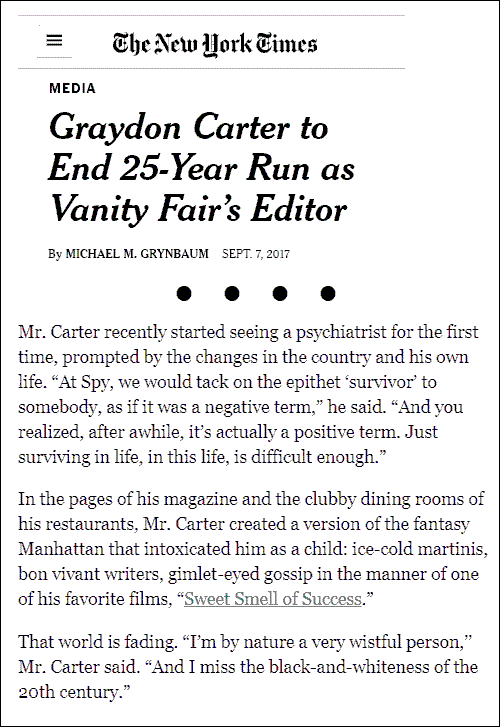
See also Sweet Smell in this journal.
Comments Off on Smell
"As the film progresses, the plot mirrors
the disorientation felt by the film's director."
— Wikipedia, Irma Vep
The director in question is one Olivier Assayas.
See also Assayas in this journal.
Comments Off on His Friend Irma
Wednesday, September 6, 2017
Comments Off on Nice Piece of Ice
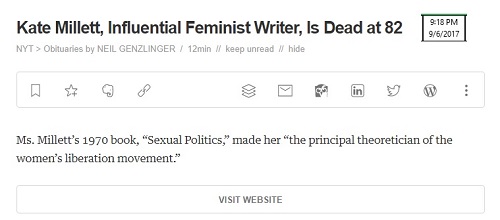
Related material —

For example —

Comments Off on Cue the Munchkins



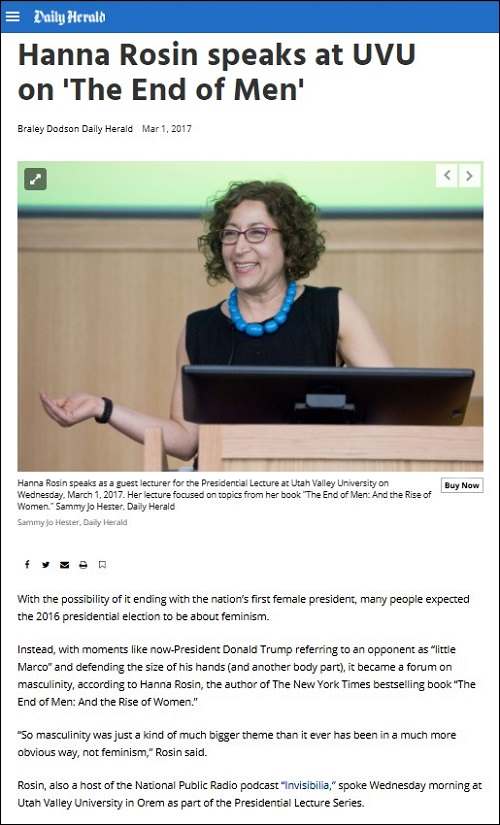
"Talk amongst yourselves."
Comments Off on Wonders of the Invisibilia World
From a search in this journal for "More Holy Water" —
A post of January 7, 2011, has the following:
"Infinite Jest… now stands as the principal contender
for what serious literature can aspire to
in the late twentieth and early twenty-first centuries."
— All Things Shining, a work of pop philosophy
published January 4th
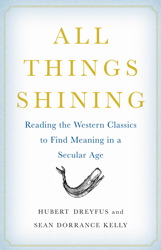
"You're gonna need a bigger boat."
— Roy Scheider in "Jaws"
"We're gonna need more holy water."
— "Season of the Witch"
Comments Off on National Comedy
In memory of weather buff Stephen Fybish,
who reportedly died at 80 on August 30.
The Eye of Harvey meets the Eye of Shangri-La —


Today's New York Times on Fybish —
"Winter was his favorite season. He liked to taste the snow,
'since that’s one of the purer forms of water that we’re likely
to encounter here in the Big Apple,' he said."
— Sam Roberts

Comments Off on Narrative
Christoph Waltz stars in the new film "Tulip Fever" —

Promotional summary —

Related material — Another Waltz film, and a document commemorated
by a Boston University professor in the previous post —

Comments Off on The Spectre of Capitalism
Tuesday, September 5, 2017
"But unlike many who left the Communist Party, I turned left
rather than right, and returned—or rather turned for the first time—
to a critical examination of Marx's work. I found—and still find—
that his analysis of capitalism, which for me is the heart of his work,
provides the best starting point, the best critical tools, with which—
suitably developed—to understand contemporary capitalism.
I remind you that this year is also the sesquicentennial of the
Communist Manifesto , a document that still haunts the capitalist world."
— From "Autobiographical Reflections," a talk given on June 5, 1998, by
John Stachel at the Max Planck Institute for the History of Science in Berlin
on the occasion of a workshop honoring his 70th birthday,
"Space-Time, Quantum Entanglement and Critical Epistemology."
From a passage by Stachel quoted in the previous post —

From the source for Stachel's remarks on Weyl and coordinatization —

Note that Stachel distorted Weyl's text by replacing Weyl's word
"symbols" with the word "quantities." —

This replacement makes no sense if the coordinates in question
are drawn from a Galois field — a field not of quantities , but rather
of algebraic symbols .
"You've got to pick up every stitch… Must be the season of the witch."
— Donovan song at the end of Nicole Kidman's "To Die For"
Comments Off on Annals of Critical Epistemology
Or: Coordinatization for Physicists
This post was suggested by the link on the word "coordinatized"
in the previous post.


I regret that Weyl's term "coordinatization" perhaps has
too many syllables for the readers of recreational mathematics —
for example, of an article on 4×4 magic squares by Conway, Norton,
and Ryba to be published today by Princeton University Press.
Insight into the deeper properties of such squares unfortunately
requires both the ability to learn what a "Galois field" is and the
ability to comprehend seven-syllable words.
Comments Off on Florence 2001
Monday, September 4, 2017
From the Log24 post "A Point of Identity" (August 8, 2016) —
A logo that may be interpreted as one-eighth of a 2x2x2 array
of cubes —

The figure in white above may be viewed as a subcube representing,
when the eight-cube array is coordinatized, the identity (i.e., (0, 0, 0)).
Comments Off on Identity Revisited
(A sequel to the previous post, Up to Date)
"Dr. Sekler lectured around the world, but one trip proved life-changing.
In 1962, the year he married, Dr. Sekler made his first trip to Nepal.
'It was the way it had been for centuries — a beautiful valley filled with
happy, peaceful people. It seemed like Shangri-La,' he told the Harvard
Gazette in 2004."
— Bryan Marquard in The Boston Globe today

See also "Eight is a gate" in this journal.
Comments Off on Labor Date

The obituary for Sekler is somewhat surprising, given that he
reportedly died on May 1, 2017. His burial is also rather late,
according to the Globe —
"A service has been held for Dr. Sekler . . . .
He will be buried Sept. 29 in a cemetery
in Vienna, in his family’s plot."
"A memorial lecture in his honor is planned for November
at the Harvard Graduate School of Design." — The Globe
"All in good time, my little pretty."
Another design note related to May Day 2017 —

Related material —
A Vanderbilt University article titled "The significance of Sheriff Bell’s
dreams at the end of No Country for Old Men," and an obituary from
a Log24 post, "Extreme Aesthetic Distance," of August 27, 2017 . . .

Comments Off on Up to Date

Cover design by Jarrod Taylor.
Book published on July 14, 2015.
For this journal on that date, see posts tagged Perspective.
Comments Off on Perspective
Comments Off on Night at the Museum
Sunday, September 3, 2017

The time is from
a screenshot
of my RSS feed.
"All in good time."
(See this morning's
Mosaic Logic.)
Comments Off on Dead Poet

See also Steely Dan in this journal.

Comments Off on Obit
Search for Stone Logic in this journal.
Comments Off on Sermon

“Lord Arglay had a suspicion that the Stone would be
purely logical. Yes, he thought, but what, in that sense,
were the rules of its pure logic?”
—Many Dimensions (1931), by Charles Williams

While you're waiting …

Click the above illustration for
some remarks on mosaics.
Comments Off on Mosaic Logic
Ivars Peterson in 2000 on a sort of conceptual art —
" Brill has tried out a variety of grid-scrambling transformations
to see what happens. Aesthetic sensibilities govern which
transformation to use, what size the rectangular grid should be,
and which iteration to look at, he says. 'Once a fruitful
transformation, rectangle size, and iteration number have been
found, the artist is in a position to create compelling imagery.' "
— "Scrambled Grids," August 28, 2000
Or not.
If aesthetic sensibilities lead to a 23-cycle on a 4×6 grid, the results
may not be pretty —

From "Geometry of the 4×4 Square."
See a Log24 post, Noncontinuous Groups, on Broomsday 2009.
Comments Off on Broomsday Revisited
Saturday, September 2, 2017

This post was suggested by the names* (if not the very abstruse
concepts ) in the Aug. 20, 2013, preprint "A Panoramic Overview
of Inter-universal Teichmuller Theory," by S. Mochizuki.
* Specifically, Jacobi and Kummer (along with theta functions).
I do not know of any direct connection between these names'
relevance to the writings of Mochizuki and their relevance
(via Hudson, 1905) to my own much more elementary studies of
the geometry of the 4×4 square.
Comments Off on A Touchstone
(A prequel to an Ursula K. Le Guin story
in Fantastic magazine, September 1962)


Cover art by Lloyd Birmingham for "Plane Jane"
Comments Off on Try to Remember the Kind of September
Ursula K. Le Guin, in Amazing Stories , Sept. 1992, published
"The Rock That Changed Things" (pp. 9-13) and her story from
thirty years earlier, "April in Paris" (Fantastic Stories , Sept. 1962.)
The latter (pp. 14-19) was followed by some brief remarks (p. 19)
comparing the two stories.
For "The Rock," see Le Guin + Rock in this journal.
"April in Paris" is about time travel by means of an alchemist's
pentagram. The following figure from 1962 is in lieu of a pentagram —

See as well a search for 1962 in this journal.
Comments Off on Knight Moves
Friday, September 1, 2017
On Ursula K. Le Guin's short story
"The Rock That Changed Things"
(in A Fisherman of the Inland Sea ) —
|
From https://www.academia.edu/9496639/
Study_Guide_for_the_Stories_Collected_in_
Ursula_K._Le_Guins_
FISHERMAN_OF_THE_INLAND_SEA
By Richard D. Erlich, December 2005
… And at this point a wise, old nur, so excellent at maintaining patterns that the obls let him live even after he was maimed, enters the discussion to do some pattern criticism. For a first-order approximation reading, he suggests "It might say, 'The nur places stones,'" and others fill in that the nur would be Bu. Ko corrects them with "patterns aren't ever about nurs!" and Bu counters with "Maybe patterns made of colors are." Looking with all three of his eyes, Ko reads, "—'the nur places stones beautifully in uncontrollable loopingness …. foreshadowing the seen.'" Un suggests "The vision" but cannot figure out the last word. Bu is very excited, inferring that "the patterns of the colors …. aren't accidental. Not meaningless. All the time, we have been putting them here in patterns—not just ones the obls design and we execute, but other patterns—nur patterns—with new meanings." Amid the straight lines of the obls' designs they now see, "other designs, less complete, often merely sketched or hinted—circles, spirals, ovals, and complex curvilinear mazes and labyrinths of great and unpredictable beauty and significance. *** Both patterns were there; did one cancel the other, or was each part of the other? It was difficult to see them both at once, but not impossible." Had the nurs done this all totally unconsciously "without even knowing we were doing it?" Un admits to having looked at colors, and so did Ko, plus "grain and texture." Un warns them to keep word of their works from the Professors: "They don't like patterns to change…. It makes them nervous"— and nervous Professors are dangerous to nurs (62-63).
Bu, however "was so excited and persuasive" about colors of stones "that other nurs of Obling began studying the color patterns, learning how to read their meanings." And the practice spreads. Soon, all sorts of nurs were finding "wild designs in colored stones, and surprising messages concerning obls, nurs, and blits" (64) Conservative nurs— "Many nurs," we're told—resist the trend. "If we start inventing new meanings, changing things, disturbing the patterns, where will it end?" It is unclear just how many of the nurs believe «Mr. Charlie treats us real good»—or, as we soon see, Ms. Charlie—but certainly not Bu; she "would hear none of that; she was full of her discovery. She no longer listened in silence. She spoke." Bu goes up to the Rectory Mosaic, wearing around her neck a turquoise that she calls her "selfstone." Up at the Mosaic, Bu crouches before the Rectoress and asks "Would the Lady Rectoress in her kindness answer a question I have?"
["The Rock That Changed Things" was first published in Amazing Stories , Vol. 67 # 6, No. 574, September 1992, pp. 9-13.]
|
For an alternative to the Rectoress, see the Abbess of the previous post.
Comments Off on Patterns for the Abbess
A detail from the previous post —

See as well Ursula in this journal.
Comments Off on Detail
Comments Off on But Seriously…
Comments Off on Harvey’s Tulips
Comments Off on That Old Jew
See references to Krell in this journal.
IMDb > Chief Quinn (Character)
From Forbidden Planet (1956) —
Chief Engineer Quinn: I'll bet any quantum mechanic
in the service would give the rest of his life to fool around
with this gadget.
Related material from the above search for Krell —

Comments Off on Krell’s Journal










 .
.




























































































